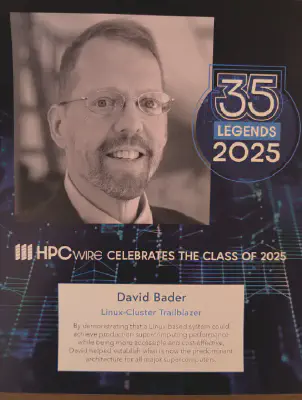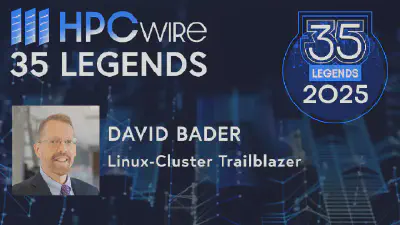The HPCwire 35 Legends of 2025
We are proud to announce the HPCwire 35 Legends Class of 2025. Our second annual list recognizes 35 luminaries who have made HPC what it is today.


The High Performance Computing (HPC) market is distinguished by the close collaboration among scientific researchers, end users, and technology vendors, all working in concert to advance the field. Our Legends are the pioneering researchers, visionary inventors, and influential executives who have translated innovative concepts into both technological breakthroughs and commercial successes.
Thirty-five honorees are announced each year, selected by HPCwire editors and advisors based on their contributions to the HPC community over the past 35 years, and celebrated for the different ways they have helped move HPC forward. The HPCwire 35 Legends Class of 2024 can be found here.
As you read through this list of HPC Legends, you’ll immediately notice their impressive stature. This year’s list does not, in any manner, prioritize by ranking; every single one of these legends are amazing, and we’re equally honored to have them in our community.
HPCwire 35 Legends Class of 2025:
Horst Simon
HPC Benchmark Pioneer and Exascale Visionary
Ralph Roskies
Co-founder of PSC
Michael Levine
Co-founder of PSC
Vinton Cerf
One of the Fathers of the Internet
Lisa Su
Leader of AMD’s Exascale Era
Thomas Lippert
Architect of Europe’s First Exascale System
Dieter Kranzlmüller
Germany’s Supercomputing Leader
Satoshi Sekiguchi
Architect of Japan’s AI Supercomputing
Susan Gregurick
Architect of NIH HPC/Data Strategy

David Bader
Linux-Cluster Trailblazer
Wu Feng
Co-Founder of Green500
Ian Buck
Inventor of CUDA
Richard Tapia
Early Champion of Diversity in HPC
Mateo Valero Cortés
Spain’s Vanguard of European HPC
Lori Diachin
Leader of the Exascale Computing Project
Jysoo Lee
Supercomputing Strategist for Korea and Saudi Arabia
Bob Borchers
Architect of U.S. NSF Supercomputing Initiatives
Beverly Clayton
The First Woman to Direct an HPC Center (PSC)
https://www.hpcwire.com/35-hpc-legends/
David Bader
Linux-Cluster Trailblazer
Dr. David Bader’s passion for HPC began early and was deeply rooted in hands-on experimentation. As an undergraduate at Lehigh University in the late 1980s, he built his first parallel computer using several Commodore Amiga 1000 personal computers that had been collecting dust in a closet, he told HPCwire. A year later, he designed parallel algorithms on a 128-processor nCUBE hypercube donated by Bell Labs.
“These early experiences taught me a fundamental lesson: building powerful parallel machines requires simultaneous development of scalable, high-performance algorithms and robust system services,” he said.
During his PhD studies at the University of Maryland, Bader had a radical (at the time) vision: that supercomputers could be constructed from commodity components while strategically incorporating high-performance technologies where they mattered most. Bader’s background in electrical engineering, computer engineering, and algorithm design provided an ideal foundation for understanding both the theoretical and practical aspects of this challenge.
This mindset led to one of Bader’s most significant contributions to HPC. In 1998 at the University of New Mexico, he developed the first Linux supercomputer using commodity off-the-shelf components at a time when most supercomputers used proprietary operating systems and specialized hardware. After a successful prototype design, he led the development of RoadRunner, the first Linux supercomputer for open use by the national science and engineering community via the NSF’s National Technology Grid. RoadRunner’s revolutionary three-network architecture and balanced design philosophy combined commodity processors with high-performance interconnects and comprehensive system management capabilities.
“The breakthrough came when I realized that the key wasn’t choosing between cost and performance but rather optimizing the integration of different technologies to maximize capability per dollar,” he told HPCwire.
By demonstrating that a Linux-based system could achieve production supercomputing performance while being more accessible and cost-effective, Bader helped establish what is now the predominant architecture for all major supercomputers worldwide. The Computer History Museum recognizes this work on its Timeline of Computer History, and in 2021, Hyperion Research estimated that the total economic value of Linux supercomputing pioneered by this work has exceeded $100 trillion over the past 25 years.
Bader has spent the years since widening HPC’s reach. At Georgia Tech he founded the School of Computational Science and Engineering. He is now a Distinguished Professor and Director of the Institute for Data Science at the New Jersey Institute of Technology, where he founded the Department of Data Science. His responsibilities include leading cutting-edge research at the intersection of HPC and real-world applications, directing an institute that encompasses research centers in AI, big data, medical informatics, quantum computing, and cybersecurity, and developing innovative academic programs including pioneering BS and PhD. programs in data science.
Bader was co-founder of the Graph500 List for benchmarking “Big Data” computing platforms, which has influenced the HPC community to look beyond LINPACK as the sole performance ranking metric and consider the irregular, data-intensive workloads that are increasingly important in modern computing.
Bader is a Fellow of IEEE, AAAS, SIAM, and ACM. He was awarded the IEEE Sidney Fernbach Award in 2021 and was inducted into the University of Maryland’s Innovation Hall of Fame the following year. This year, he was inducted into the Mimms Museum of Technology and Art Hall of Fame and received the Heatherington Award for Technological Innovation.
Looking to the horizon of the discipline he helped shape, Bader concludes, “Having witnessed the transformation of HPC from proprietary systems to the Linux-dominated landscape we have today, I’m now focused on ensuring that future HPC systems are not just faster, but more accessible and applicable to the challenges that matter most to humanity. Whether it’s protecting our digital infrastructure, accelerating scientific discovery, or enabling new forms of artificial intelligence, HPC has the potential to be the foundation for solving the defining challenges of the 21st century.”